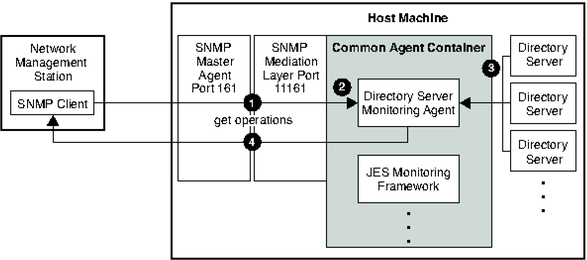| Skip Navigation Links | |
| Exit Print View | |

|
Oracle Directory Server Enterprise Edition Reference 11 g Release 1 (11.1.1.5.0) |
| Skip Navigation Links | |
| Exit Print View | |

|
Oracle Directory Server Enterprise Edition Reference 11 g Release 1 (11.1.1.5.0) |
1. Directory Server Enterprise Edition File Reference
Software Layout for Directory Server Enterprise Edition
Directory Server Instance Default Layout
Directory Proxy Server Instance Default Layout
Part I Directory Server Reference
4. Directory Server LDIF and Search Filters
6. Directory Server Monitoring
Ways to Monitor Directory Server
Directory Server Monitoring Attributes
cn=monitor,cn=Class of Service,cn=plugins, cn=config
classicHashAvgClashPercentagePerHash
7. Directory Server Replication
8. Directory Server Data Caching
11. Directory Server Groups and Roles
12. Directory Server Class of Service
14. Directory Server Internationalization Support
Part II Directory Proxy Server Reference
15. Directory Proxy Server Overview
16. Directory Proxy Server Load Balancing and Client Affinity
17. Directory Proxy Server Distribution
18. Directory Proxy Server Virtualization
19. Connections Between Directory Proxy Server and Backend LDAP Servers
20. Connections Between Clients and Directory Proxy Server
21. Directory Proxy Server Client Authentication
22. Security in Directory Proxy Server
23. Directory Proxy Server Logging
Directory Server implements the dsTable and the dsApplIfOpsTable of the Directory Server Monitoring MIB defined by RFC 2605. It does not implement the dsIntTable.
Directory Server also implements the Network Services Monitoring MIB defined by RFC 2788.
Directory Server support for SNMP has the following limitations.
SNMP support is for monitoring only, no SNMP management is supported.
No SNMP traps are implemented.
This rest of this section explains how the information flows from the monitoring application to Directory Server and back, particularly in the case where you use SNMP.
The SNMP interface is exposed by Java ES MF. See the Sun Java Enterprise System 5 Update 1 Monitoring Guide for details.
The monitoring framework is contained within the Common Agent Container, cacao, which is installed alongside Directory Server. Figure 6-1 shows the monitoring framework.
Figure 6-1 Overall Monitoring Information Flow

SNMP support for monitoring Directory Server is managed by a Directory Server agent in the Common Agent Container. On Directory Server startup, the Monitoring server plug-in registers theDirectory Server instance with the Directory Server agent within the Common Agent Container.
Figure 6-2 shows how SNMP information about Directory Server flows through the Common Agent Container.
Figure 6-2 SNMP Information Flow

SNMP information about Directory Server flows as follows.
The network management station sends a GET message through the master SNMP agent, which by default uses standard port 161, to the SNMP mediation layer, which by default uses port 11161.
For information about how to configure access to the SNMP mediation layer, see the Sun Java Enterprise System 5 Update 1 Monitoring Guide.
The SNMP mediation layer forwards any requests destined for the Directory Server to the Directory Server agent.
When the server state changes, Directory Server pushes SNMP information to the Directory Server agent.
The Directory Server agent relays the response back to the SNMP client via the SNMP mediation layer and master SNMP agent to the network management station. The network management station then displays the data through its network management application.